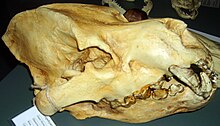Percrocutidae
| Percrocutidae | ||||||||||||
|---|---|---|---|---|---|---|---|---|---|---|---|---|

Dinocrocuta |
||||||||||||
| Temporal occurrence | ||||||||||||
| lower Miocene to Upper Pliocene | ||||||||||||
| 20 to 2.59 million years | ||||||||||||
| Locations | ||||||||||||
| Systematics | ||||||||||||
|
||||||||||||
| Scientific name | ||||||||||||
| Percrocutidae | ||||||||||||
| Werdelin & Solounias , 1991 | ||||||||||||
The family of percrocutidae is an extinct line of feline predators. Originally they were assigned to the hyenas , but today they are considered a separate family. They developed similar characteristics to the hyenas and are likely to have occupied the ecological niche of the large, scavenging hyenas when the hyenas themselves consisted exclusively of small, crawly cat-like forms. The first percrocutids come from the middle Miocene of Europe and Western Asia and belonged to the genus Percrocuta . Percrocuta already showed a tendency towards enlarged premolars, however, did not yet have such a massive bite as the later Dinocrocuta form from the late Miocene, which was also suitable for cracking very large bones. The latter genus was reconstructed to weigh up to 380 kg, assuming a hyena-like physique.
Occasionally it is recommended that the Percrocutidae be grouped together with other genera, such as Stenoplesictis , to form the Stenoplesictidae family.

literature
- Alan Turner, Mauricio Antón: Evolving Eden. An Illustrated Guide to the Evolution of the African Large-Mammal Fauna. Columbia University Press, New York NY 2004, ISBN 0-231-11944-5 .
- Jordi Augusti, Mauricio Antón: Mammoths, Sabertooths, and Hominids. 65 Million Years of Mammalian Evolution in Europe. Columbia University Press, New York NY et al. 2002, ISBN 0-231-11640-3 .
Individual evidence
- ↑ Deng Tao and Tseng Zhijie J: Osteological evidence for predatory behavior of the giant percrocutid (Dinocrocuta gigantea) as an active hunter. Chinese Science Bulletin 55 (17), 2010, pp. 1790-1794